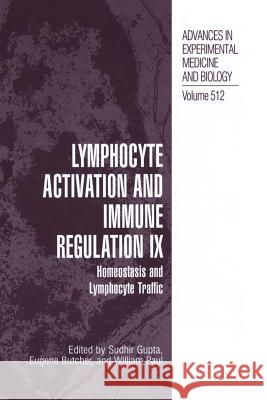Lymphocyte Activation and Immune Regulation IX: Homeostasis and Lymphocyte Traffic » książka
Lymphocyte Activation and Immune Regulation IX: Homeostasis and Lymphocyte Traffic
ISBN-13: 9781461352266 / Angielski / Miękka / 2012 / 212 str.
During the past five years major progress has been made in understanding the basic mechanisms of lymphocyte homeostasis and in the developmental relationship between different memory T subsets and their traffic patterns and functional significance. This volume highlights the current concepts of lymphocyte development, factors regulating lymphocyte trafficking and development, and specialized characteristics and functional properties of naive and memory subsets.
This volume is divided into three sections. Section I deals with factors that regulate the development and maturation of T cells and B cells and lymphocyte traffic. The significance of C-kit, Bcl-6, IL-7, and Vav in the development of T and B lymphocytes is discussed. A role of lymphotoxins and VAP-I in trafficking of leucocytes is reviewed. Finally, the trafficking and homing characteristics of T cell and B cell subsets, and the regulation of these processes during the immune response, is presented.
Section II discusses various aspects of naive and memory T cell biology, including clonal expansion, reprogramming of genes including those encoding cytokines and cytotoxic granules, changes in the expression of cell surface proteins involved in cell-cell adhesion, homing of naive and memory T cells, the role of MHC and cytokines in the maintenance of naive and memory T cells, and the characterization and differentiation of virus-specific memory T cell heterogeneity in mice and humans.
Novel methods of visualization of immune cells and immune systems are reviewed in Section III. This includes tracking of dendritic cells in vivo, monitoring arterial smooth muscle-specific T cells in the inflamed vasculature, imaging of molecular migrations in immune synapses, and visualization of various immune cells in intact lymphoid tissues by two photon confocal imaging.
This volume should be of interest to immunologists, molecular biologists, microbiologists, pathologists, academic physicians, cell biologists, and scientists and clinicians interested in vaccine development.











